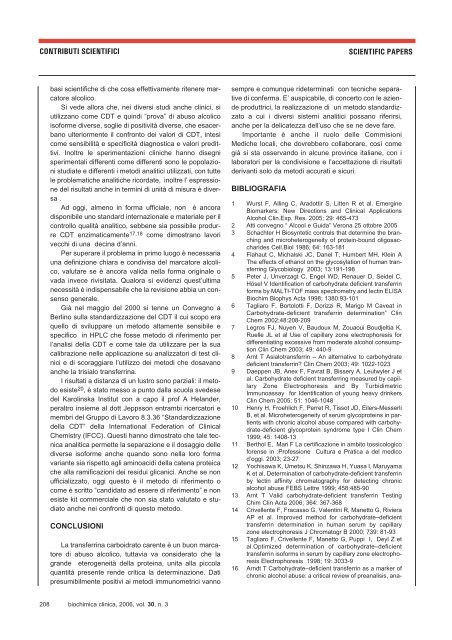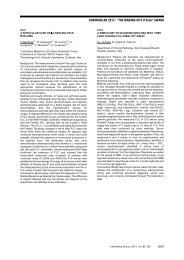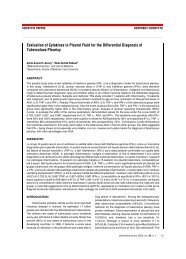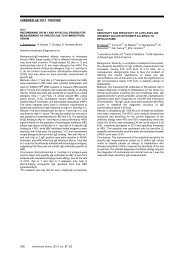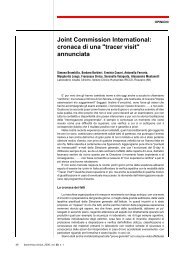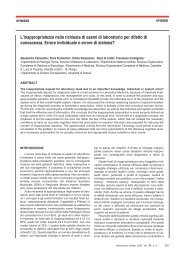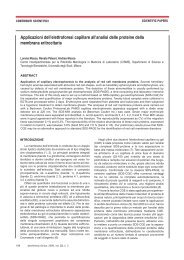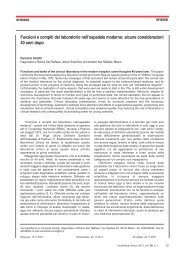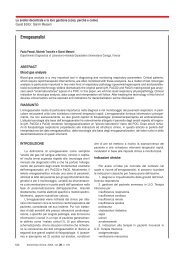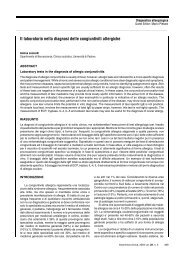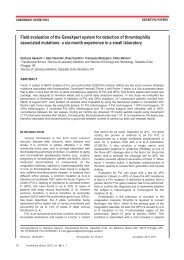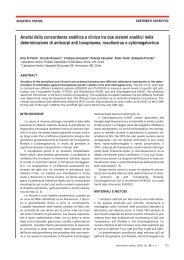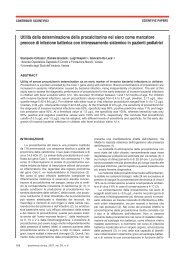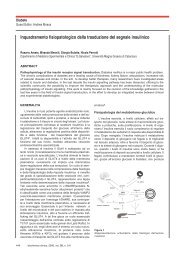Transferrina carboidrato carente: marcatore di abuso ... - SIBioC
Transferrina carboidrato carente: marcatore di abuso ... - SIBioC
Transferrina carboidrato carente: marcatore di abuso ... - SIBioC
You also want an ePaper? Increase the reach of your titles
YUMPU automatically turns print PDFs into web optimized ePapers that Google loves.
CONTRIBUTI SCIENTIFICI SCIENTIFIC PAPERS<br />
basi scientifiche <strong>di</strong> che cosa effettivamente ritenere <strong>marcatore</strong><br />
alcolico.<br />
Si vede allora che, nei <strong>di</strong>versi stu<strong>di</strong> anche clinici, si<br />
utilizzano come CDT e quin<strong>di</strong> “prova” <strong>di</strong> <strong>abuso</strong> alcolico<br />
isoforme <strong>di</strong>verse, soglie <strong>di</strong> positività <strong>di</strong>verse, che esacerbano<br />
ulteriormente il confronto dei valori <strong>di</strong> CDT, intesi<br />
come sensibilità e specificità <strong>di</strong>agnostica e valori pre<strong>di</strong>ttivi.<br />
Inoltre le sperimentazioni cliniche hanno <strong>di</strong>segni<br />
sperimentali <strong>di</strong>fferenti come <strong>di</strong>fferenti sono le popolazioni<br />
stu<strong>di</strong>ate e <strong>di</strong>fferenti i meto<strong>di</strong> analitici utilizzati, con tutte<br />
le problematiche analitiche ricordate, inoltre l’ espressione<br />
del risultati anche in termini <strong>di</strong> unità <strong>di</strong> misura è <strong>di</strong>versa<br />
.<br />
Ad oggi, almeno in forma ufficiale, non è ancora<br />
<strong>di</strong>sponibile uno standard internazionale e materiale per il<br />
controllo qualità analitico, sebbene sia possibile produrre<br />
CDT enzimaticamente 17,18 come <strong>di</strong>mostrano lavori<br />
vecchi <strong>di</strong> una decina d’anni.<br />
Per superare il problema in primo luogo è necessaria<br />
una definizione chiara e con<strong>di</strong>visa del <strong>marcatore</strong> alcolico,<br />
valutare se è ancora valida nella forma originale o<br />
vada invece rivisitata. Qualora si evidenzi quest’ultima<br />
necessità è in<strong>di</strong>spensabile che la revisione abbia un consenso<br />
generale.<br />
Già nel maggio del 2000 si tenne un Convegno a<br />
Berlino sulla standar<strong>di</strong>zzazione del CDT il cui scopo era<br />
quello <strong>di</strong> sviluppare un metodo altamente sensibile e<br />
specifico in HPLC che fosse metodo <strong>di</strong> riferimento per<br />
l’analisi della CDT e come tale da utilizzare per la sua<br />
calibrazione nelle applicazione su analizzatori <strong>di</strong> test clinici<br />
e <strong>di</strong> scoraggiare l’utilizzo dei meto<strong>di</strong> che dosavano<br />
anche la trisialo transferrina.<br />
I risultati a <strong>di</strong>stanza <strong>di</strong> un lustro sono parziali: il metodo<br />
esiste 20 , è stato messo a punto dalla scuola svedese<br />
del Karolinska Institut con a capo il prof A Helander,<br />
peraltro insieme al dott Jeppsson entrambi ricercatori e<br />
membri del Gruppo <strong>di</strong> Lavoro 8.3.36 “Standar<strong>di</strong>zzazione<br />
della CDT” della International Federation of Clinical<br />
Chemistry (IFCC). Questi hanno <strong>di</strong>mostrato che tale tecnica<br />
analitica permette la separazione e il dosaggio delle<br />
<strong>di</strong>verse isoforme anche quando sono nella loro forma<br />
variante sia rispetto agli aminoaci<strong>di</strong> della catena proteica<br />
che alla ramificazioni dei residui glicanici. Anche se non<br />
ufficializzato, oggi questo è il metodo <strong>di</strong> riferimento o<br />
come è scritto “can<strong>di</strong>dato ad essere <strong>di</strong> riferimento” e non<br />
esiste kit commerciale che non sia stato valutato e stu<strong>di</strong>ato<br />
anche nei confronti <strong>di</strong> questo metodo.<br />
CONCLUSIONI<br />
La transferrina <strong>carboidrato</strong> <strong>carente</strong> è un buon <strong>marcatore</strong><br />
<strong>di</strong> <strong>abuso</strong> alcolico, tuttavia va considerato che la<br />
grande eterogeneità della proteina, unita alla piccola<br />
quantità presente rende critica la determinazione. Dati<br />
presumibilmente positivi ai meto<strong>di</strong> immunometrici vanno<br />
208 biochimica clinica, 2006, vol. 30, n. 3<br />
sempre e comunque rideterminati con tecniche separative<br />
<strong>di</strong> conferma. E’ auspicabile, <strong>di</strong> concerto con le aziende<br />
produttrici, la realizzazione <strong>di</strong> un metodo standar<strong>di</strong>zzato<br />
a cui i <strong>di</strong>versi sistemi analitici possano riferirsi,<br />
anche per la delicatezza dell’uso che se ne deve fare.<br />
Importante è anche il ruolo delle Commisioni<br />
Me<strong>di</strong>che locali, che dovrebbero collaborare, così come<br />
già si sta osservando in alcune province italiane, con i<br />
laboratori per la con<strong>di</strong>visione e l’accettazione <strong>di</strong> risultati<br />
derivanti solo da meto<strong>di</strong> accurati e sicuri.<br />
BIBLIOGRAFIA<br />
1 Wurst F, Alling C, Aradottir S, Litten R et al. Emergine<br />
Biomarkers: New Directions and Clinical Applications<br />
Alcohol Clin.Exp. Res. 2005; 29: 465-473<br />
2 Atti convegno “ Alcool e Guida” Verona 25 ottobre 2005<br />
3 Schachter H Biosyntetic controls that determine the branching<br />
and microheterogeneity of protein-bound oligosaccharides<br />
Cell.Biol 1986; 64: 163-181<br />
4 Flahaut C, Michalski JC, Danel T, Humbert MH, Klein A<br />
The effects of ethanol on the glycosylation of human transferring<br />
Glycobiology 2003; 13:191-198<br />
5 Peter J, Unverzagt C, Engel WD, Renauer D, Seidel C,<br />
Hösel V Identification of carbohydrate deficient transferrin<br />
forms by MALTI-TOF mass spectrometry and lectin ELISA<br />
Biochim Biophys Acta 1998; 1380:93-101<br />
6 Tagliaro F, Bortolotti F, Dorizzi R, Marigo M Caveat in<br />
Carbohydrate-deficient transferrin determination” Clin<br />
Chem 2002;48:208-209<br />
7 Legros FJ, Nuyen V, Baudoux M, Zouaoui Boudjeltia K,<br />
Ruelle JL et al Use of capillary zone electrophoresis for<br />
<strong>di</strong>fferentiating excessive from moderate alcohol consumption<br />
Clin Chem 2003; 49: 440-9<br />
8 Arnt T Asialotransferrin – An alternative to carbohydrate<br />
deficient transferrin? Clin Chem 2003; 49: 1022-1023<br />
9 Daeppen JB, Anex F, Favrat B, Bissery A, Leutwyler J et<br />
al. Carbohydrate deficient transferring measured by capillary<br />
Zone Electrophoresis and By Turbi<strong>di</strong>metric<br />
Immunoassay for Identification of young heavy drinkers<br />
Clin Chem 2005; 51: 1046-1048<br />
10 Henry H, Froehlich F, Perret R, Tissot JD, Eilers-Messerli<br />
B, et al. Microheterogeneity of serum glycoproteins in partients<br />
with chronic alcohol abuse compared with carbohydrate-deficient<br />
glycoprotein syndrome type I Clin Chem<br />
1999; 45: 1408-13<br />
11 Berthol E, Mari F La certificazione in ambito tossicologico<br />
forense in :Professione Cultura e Pratica a del me<strong>di</strong>co<br />
d’oggi. 2003; 23-27<br />
12 Yochisawa K, Umetsu K, Shinzawa H, Yuasa I, Maruyama<br />
K et al. Determination of carbohydrate-deficient transferrin<br />
by lectin affinity chromatography for detecting chronic<br />
alcohol abuse FEBS Lettre 1999; 458:485-90<br />
13 Arnt T Valid carbohydrate-deficient transferrin Testing<br />
Chim Clin Acta 2006; 364: 367-368<br />
14 Crivellente F, Fracasso G, Valentini R, Manetto G, Riviera<br />
AP et al. Improved method for carbohydrate–deficient<br />
transferrin determination in human serum by capillary<br />
zone electrophoresis J Chromatogr B 2000; 739: 81-93<br />
15 Tagliaro F, Crivellente F, Manetto G, Puppi I, Deyl Z et<br />
al.Optimized determination of carbohydrate–deficient<br />
transferrin isoforms in serum by capillary zone electrophoresis<br />
Electrophoresis 1998; 19: 3033-9<br />
16 Arndt T Carbohydrate–deficient transferrin as a marker of<br />
chronic alcohol abuse: a critical review of preanalisis, ana-


